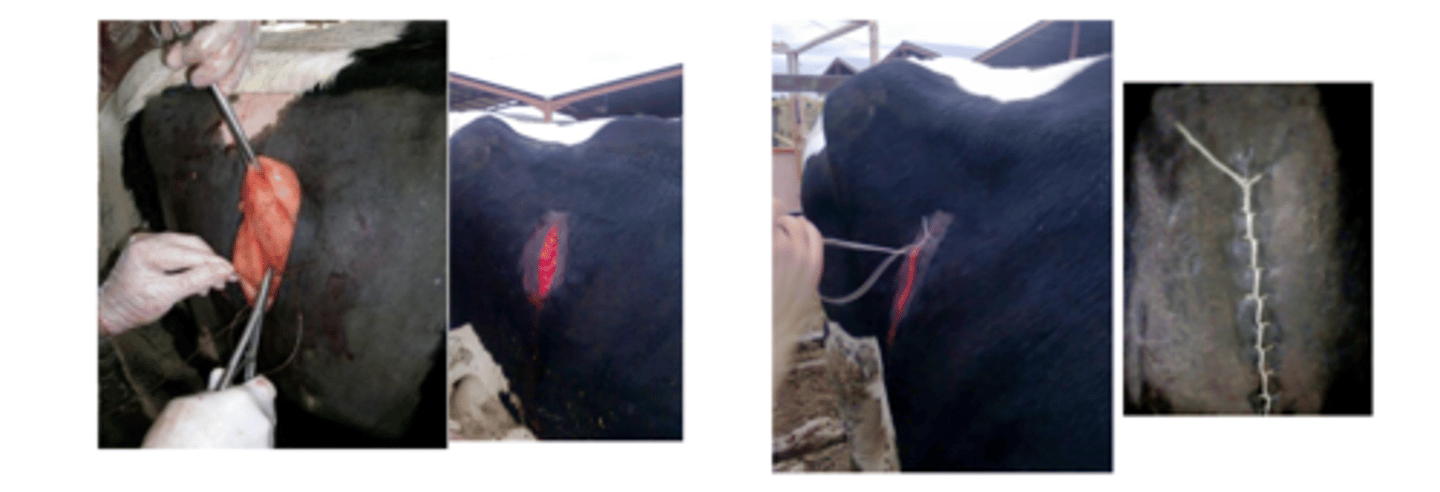pathophysiology of ruminant gastric compartments
1/55
There's no tags or description
Looks like no tags are added yet.
Name | Mastery | Learn | Test | Matching | Spaced |
|---|
No study sessions yet.
56 Terms
ruminants can use _______ as a major source of dietary fiber and energy
plant walls
they transform poor quality forages, crop residues, or other by-products into high quality meat and milk.
can ruminants survive off of forage ONLY?
no, forage is not enough to keep up with the enormous energy and protein demand, so we need to use concentrate (grain)
what is the main role of the reticulum?
particle separation
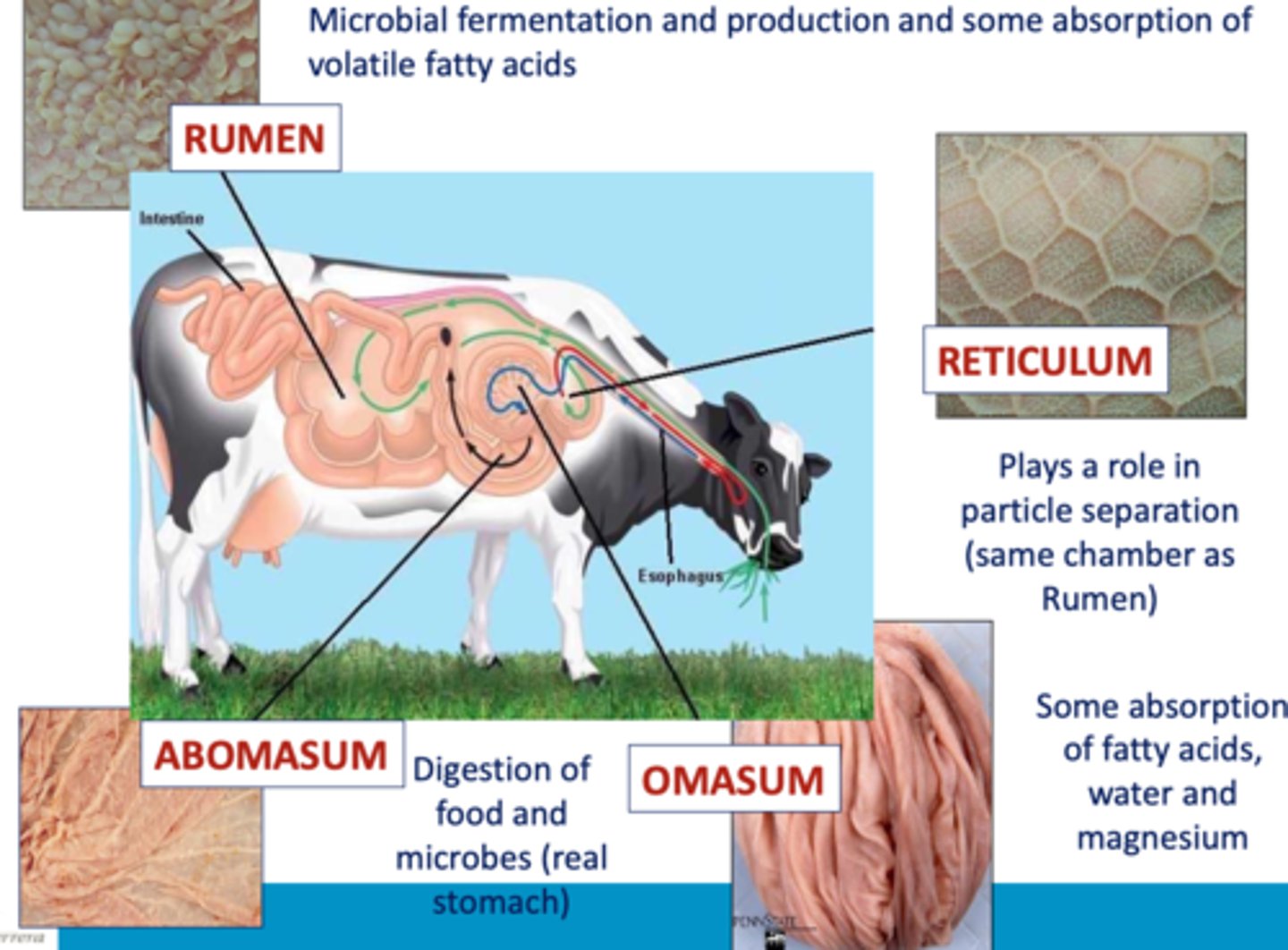
what is the main role of the rumen?
microbial fermentation and production and some absorption of volatile fatty acids
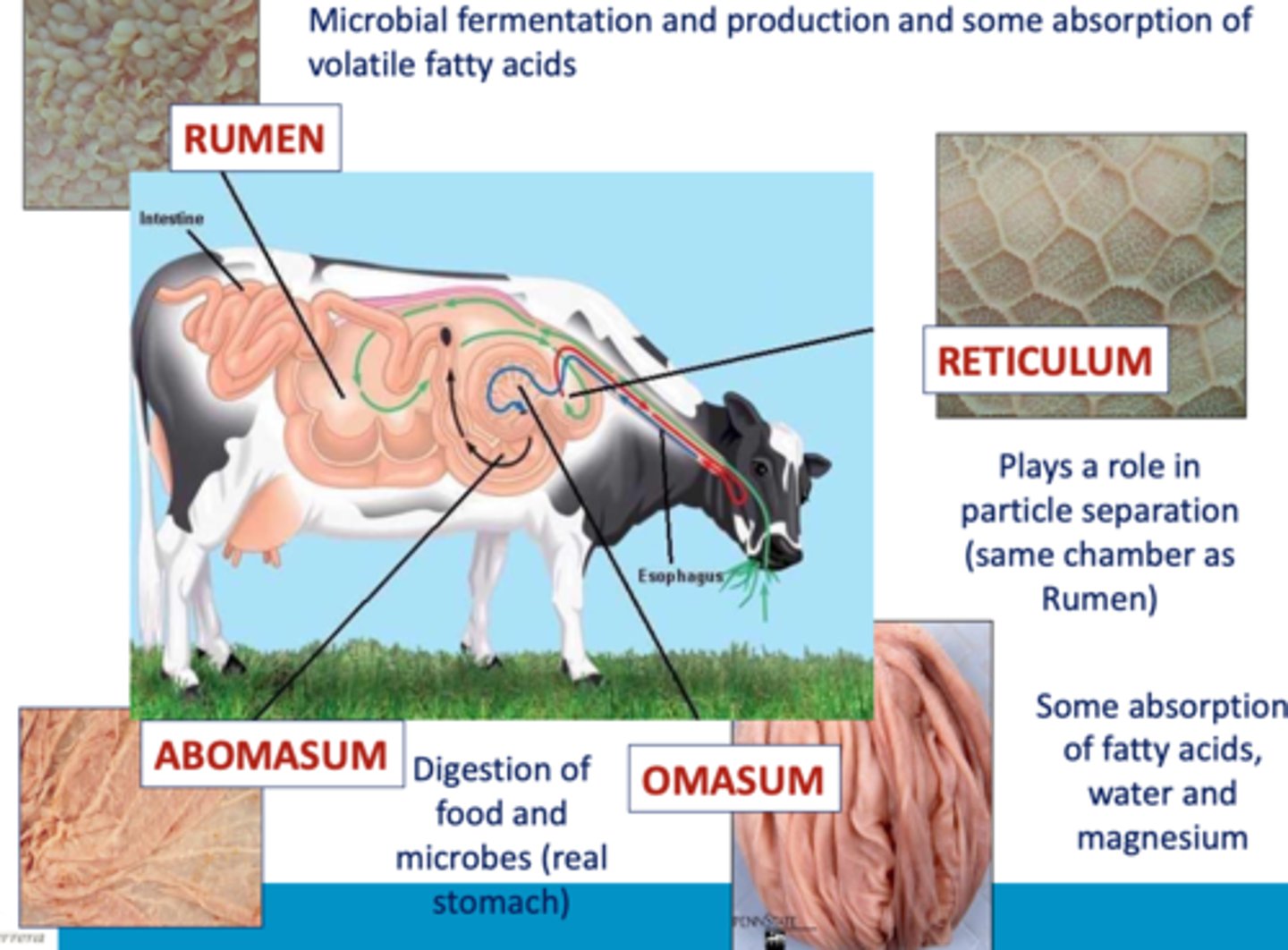
where does most microbial fermentation occur in the ruminant?
rumen
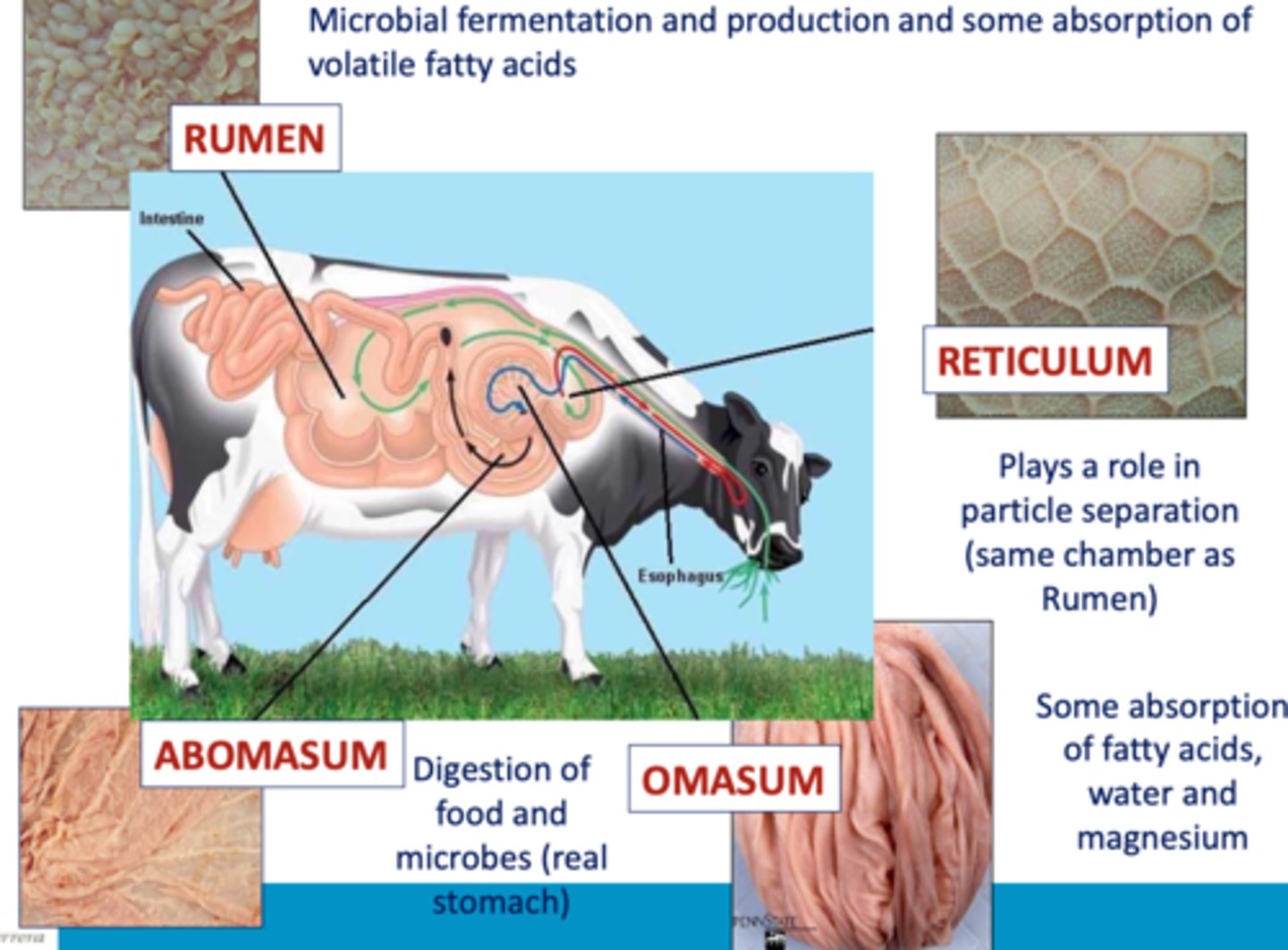
what is the role of the omasum?
some absorption of fatty acids, water, and magnesium
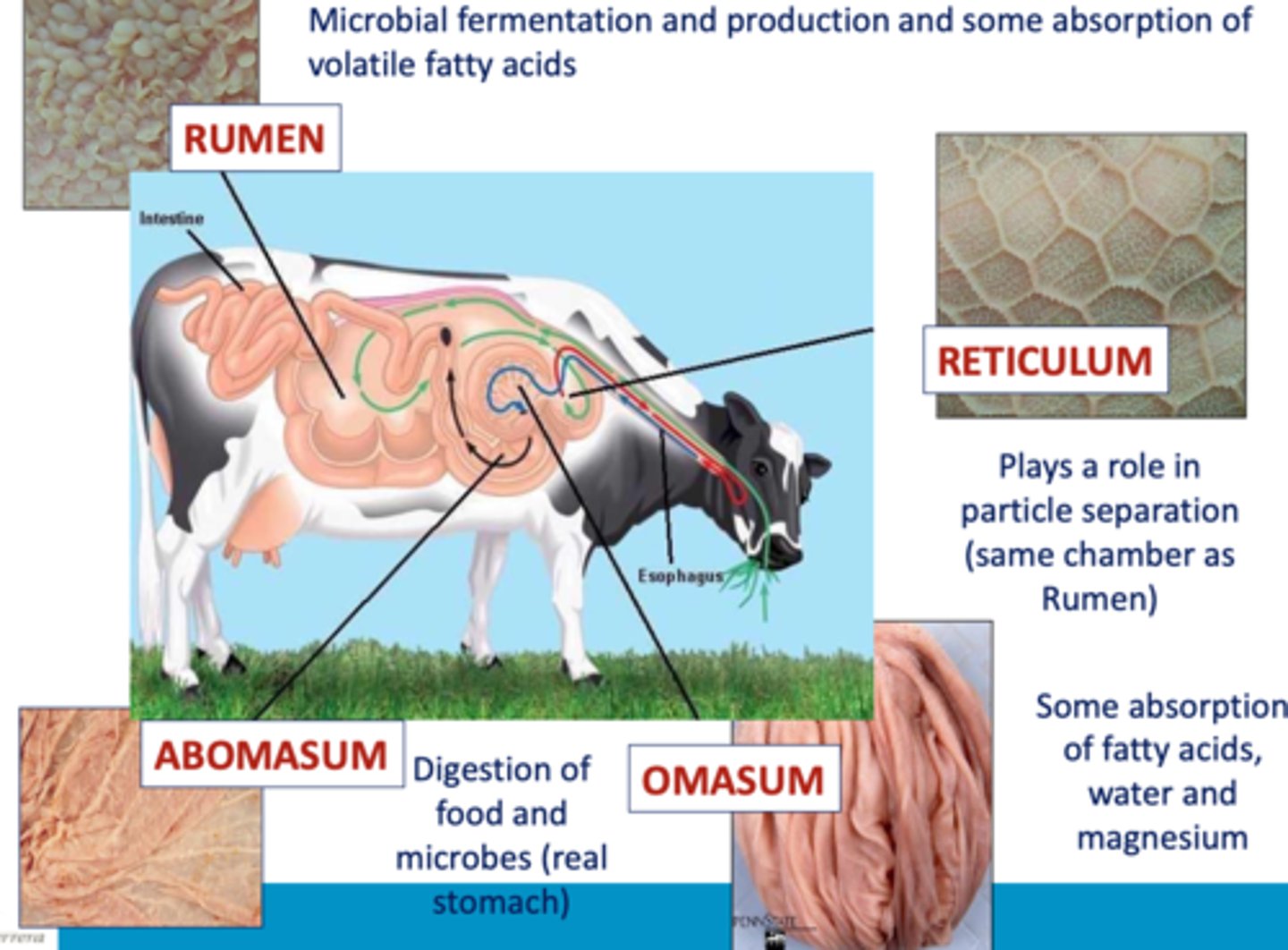
which stomach compartment has the role of water, fatty acid, and magnesium absorption?
omasum
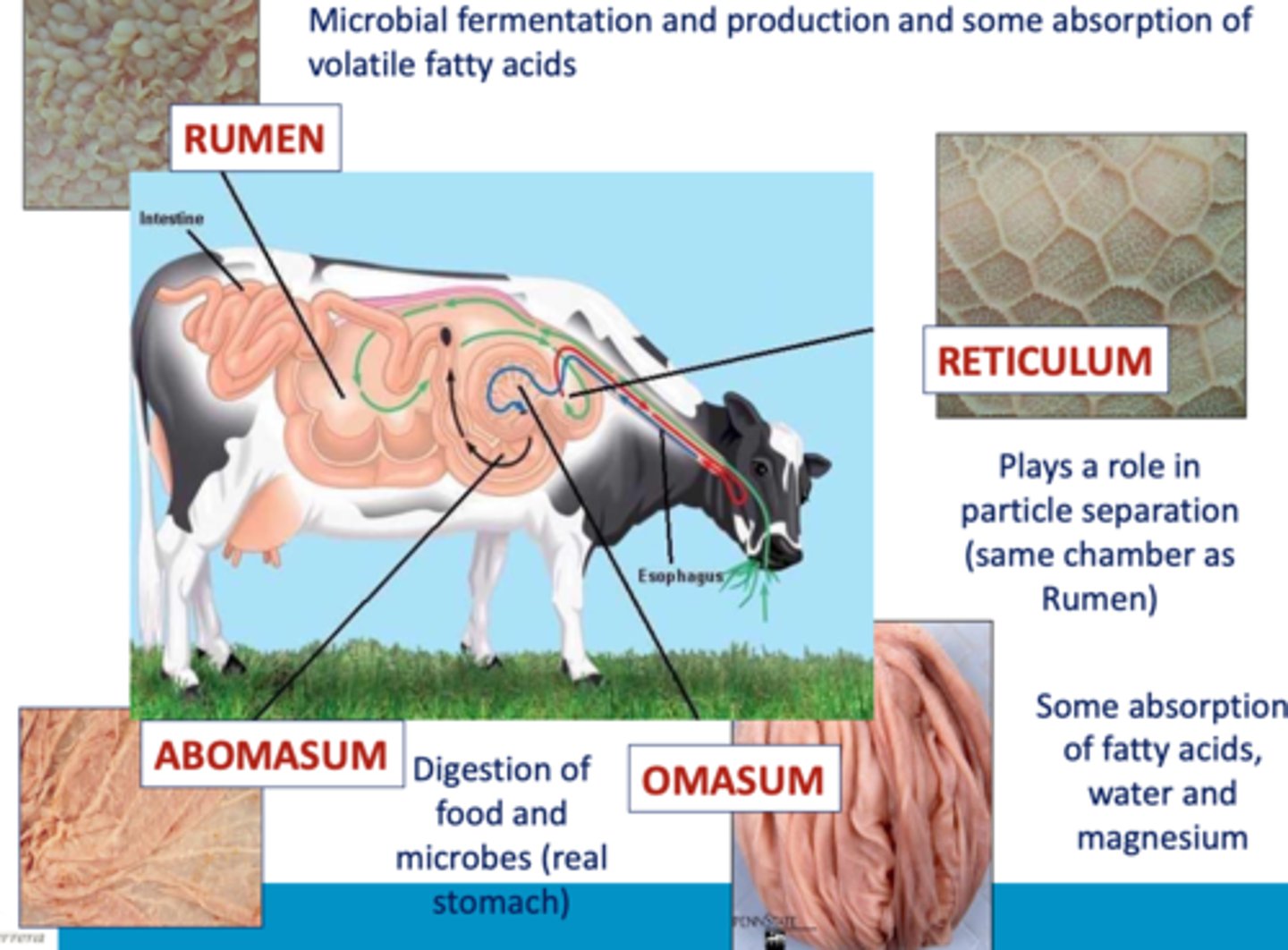
what is the role of the abomasum?
digestion of food an microbes
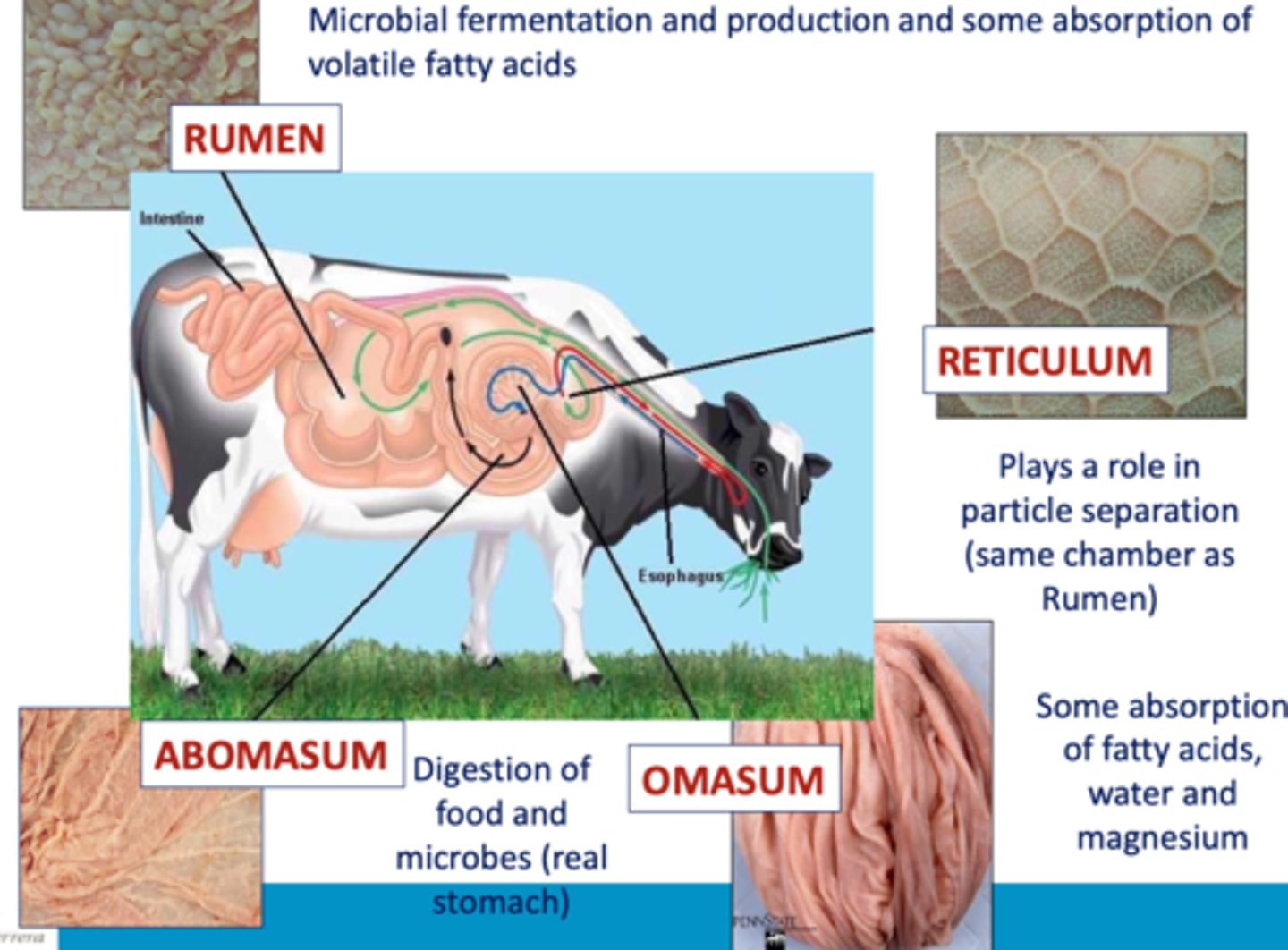
microbial enzymes in the rumen turn carbohydrates into _____
volatile fatty acids + keto acids

what is the process of turning carbohydrates into proteins and amino acids?
microbial enzymes transform carbohydrates into volatile fatty acids + keto acids. then, they turn the keto acids into amino acids, which can be converted into microbial proteins.
the microbial proteins can be turned by the animal enzymes back into free animo acids is necessary, and most are absorbed from the small intestine and used by the animal.
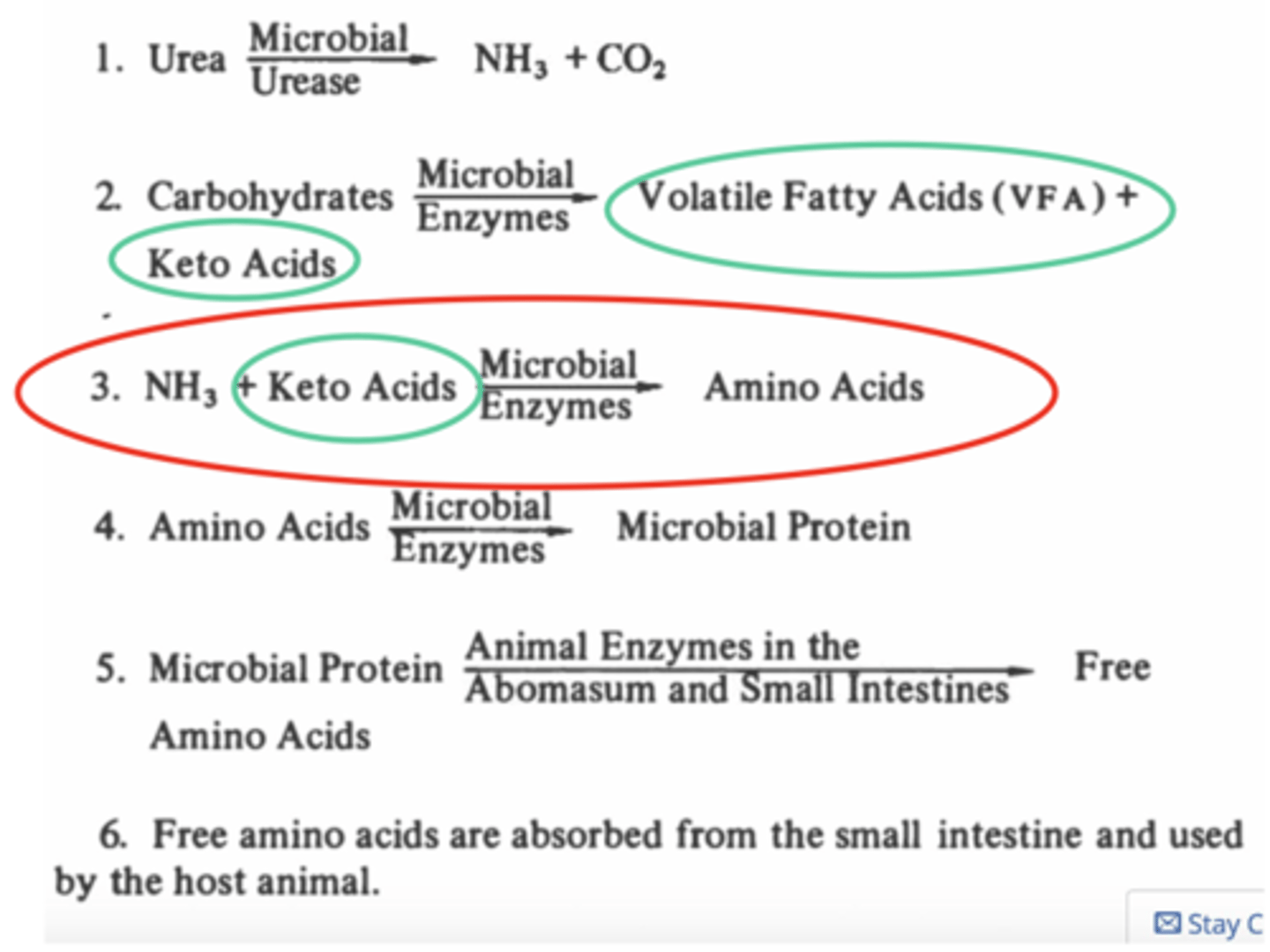
How does the ruminant cope with such a high quantity of acids in the rumen?
1. its saliva is rich in bicarbonate (it produces hundreds of liters per day)
2. ruminating (chewing the cud over and over again to mix with the saliva)
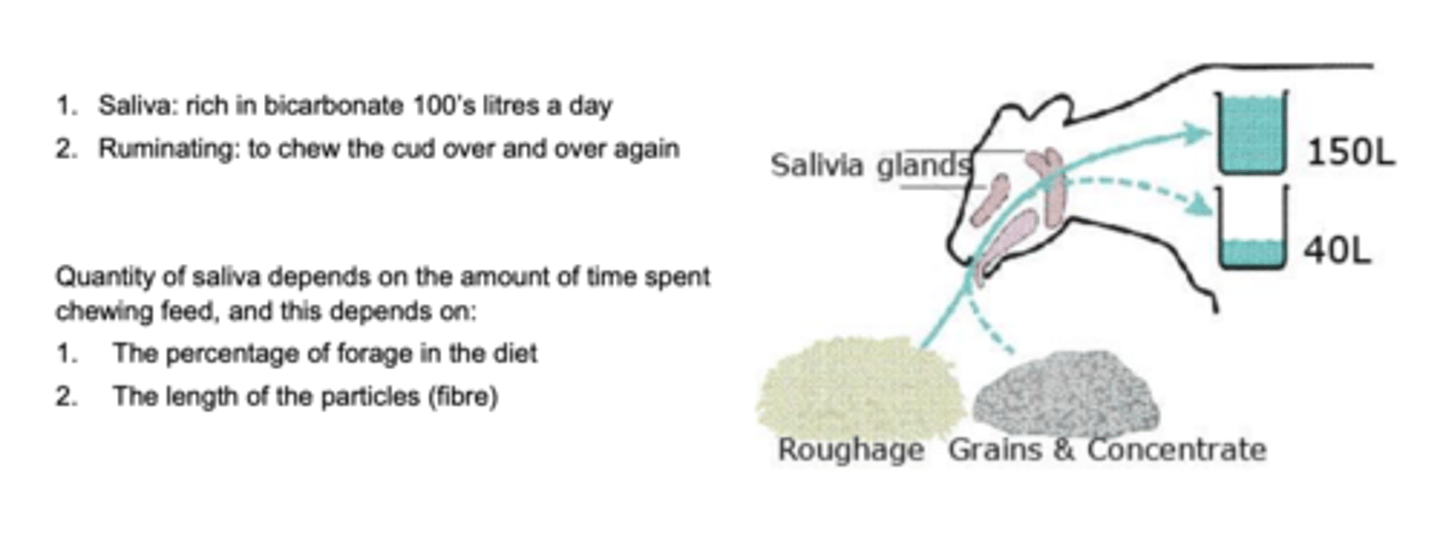
the quantity of saliva that a ruminant produces is necessary for....
being able to cope with the large amount of acids in the rumen
the quantity of saliva that a ruminant produces depends on:
1. the percentage of forage in the diet
2. the length of the particles

what are the general (non-specific) signs of GI disorders?
-no fever
-↓ appetite
-reduction in milk production
-physical alteration of the abdomen
-abnormal consistency of gastric contents
-abnormal volume, color, and consistency of the feces
these are all "ADR syndrome" (ain't doing right)
what signs are specific of gastric disease?
1. acute ruminal bloat (meteroism)
2. traumatic reticuloperitonitis (hardware disease)
3. displacement of the abomasum
what is ruminal bloat (meteorism)?
accumulation of gas, causing distension of the rumenoreticulum with the gases of fermentation
aka ruminal tympanism
acute (sometimes chronic)
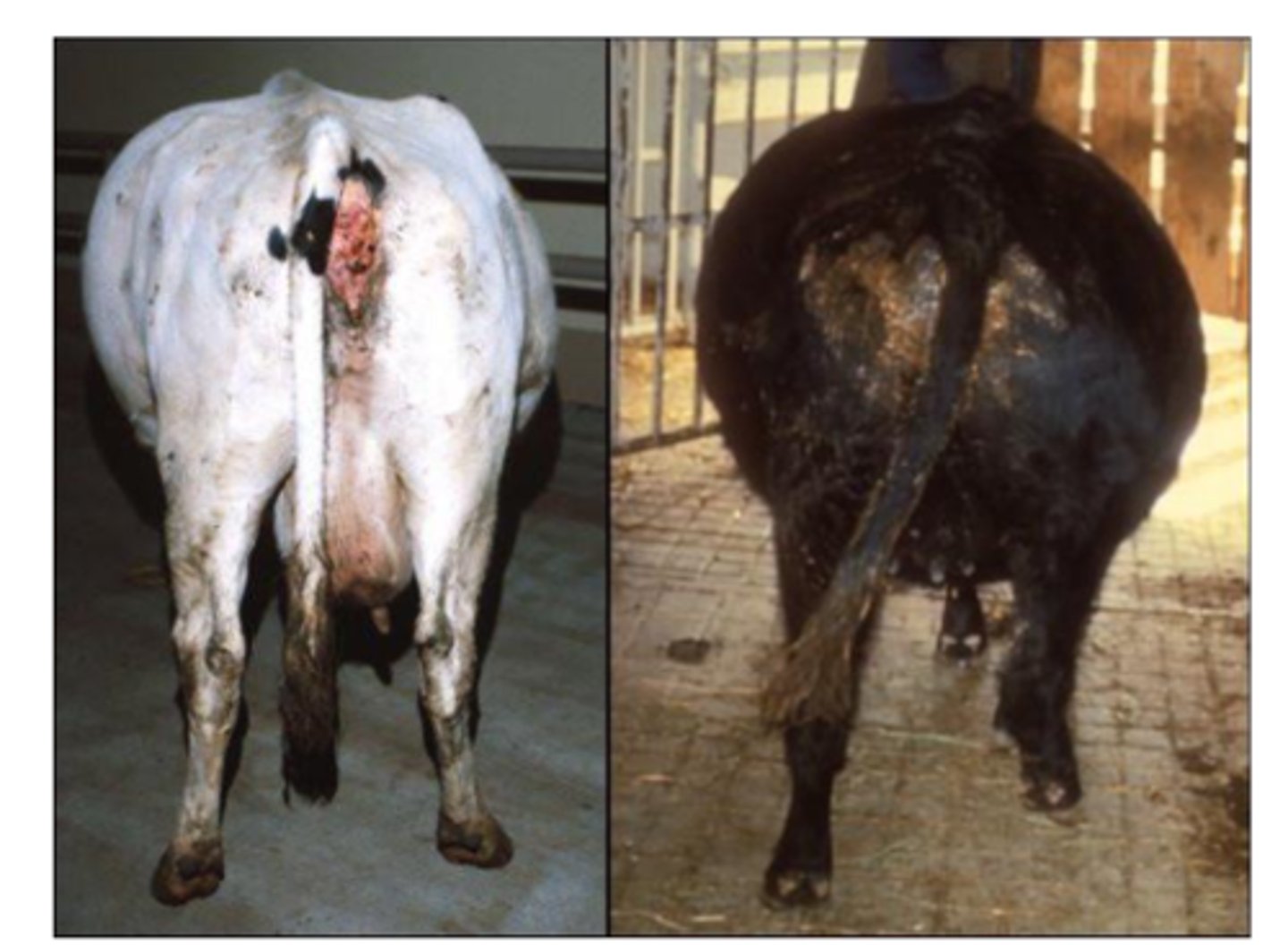
the accumulation of gas, causing distension of the rumenoreticulum with the gases of fermentation is callled...
ruminal bloat/ tympanism/ meteorism
what is the pathophysiology of ruminal bloat/tympanism/meteorism?
any interference with eructation → accumulation of gases → diaphragmatic compression → respiratory and circulatory insufficiency

what can cause ruminal bloat?
any interference with eructation
1. physical obstruction
2. frothy bloat- entrapment of the gases in a stable foam
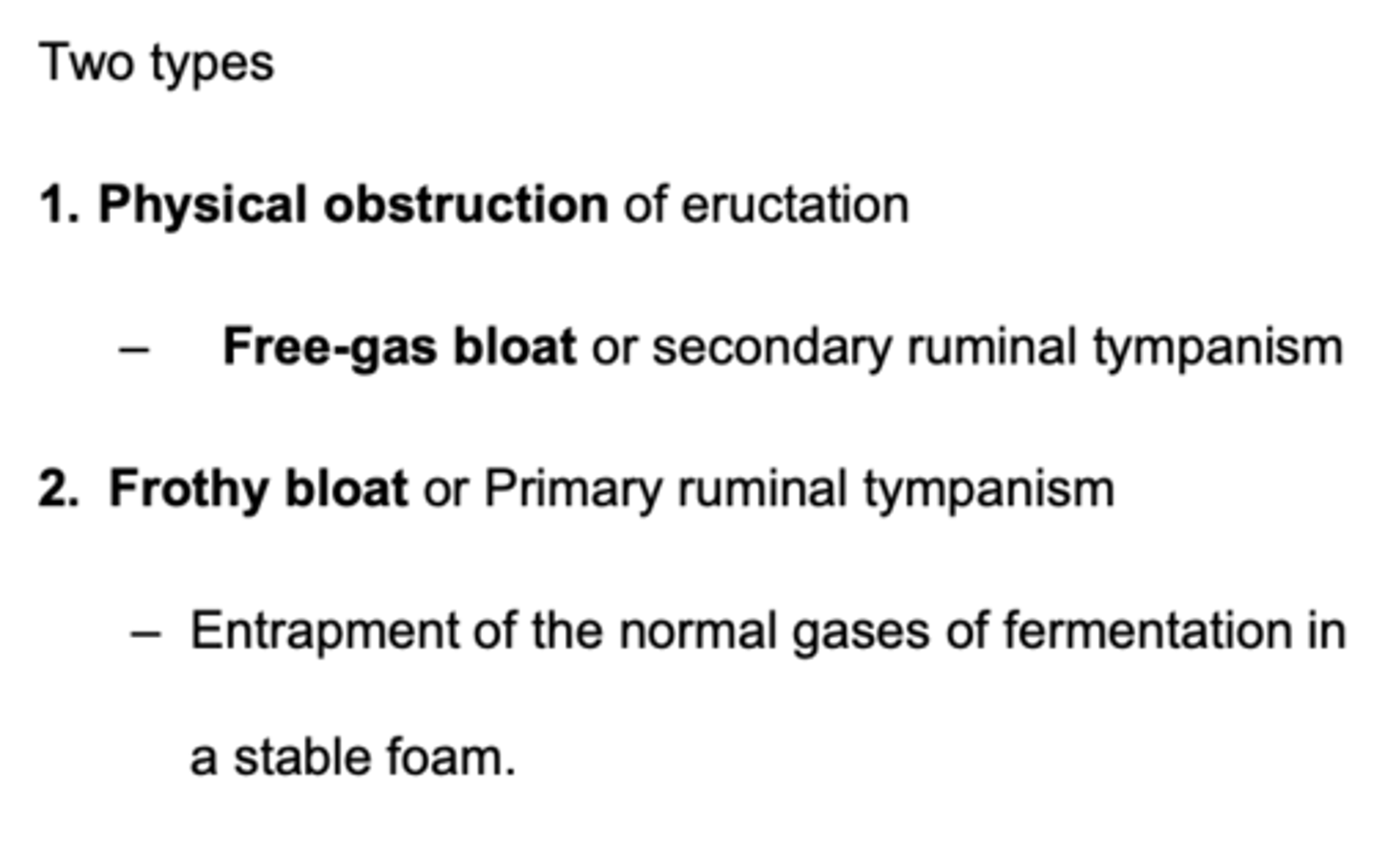
what is free-gas bloat?
ruminal bloat caused by a physical obstruction of eructation OR a motility problem
-foreign body
-stenosis
-pressure from outside of the esophagus
-alteration of esophageal motility (due to hypocalcemia or vagal damage)
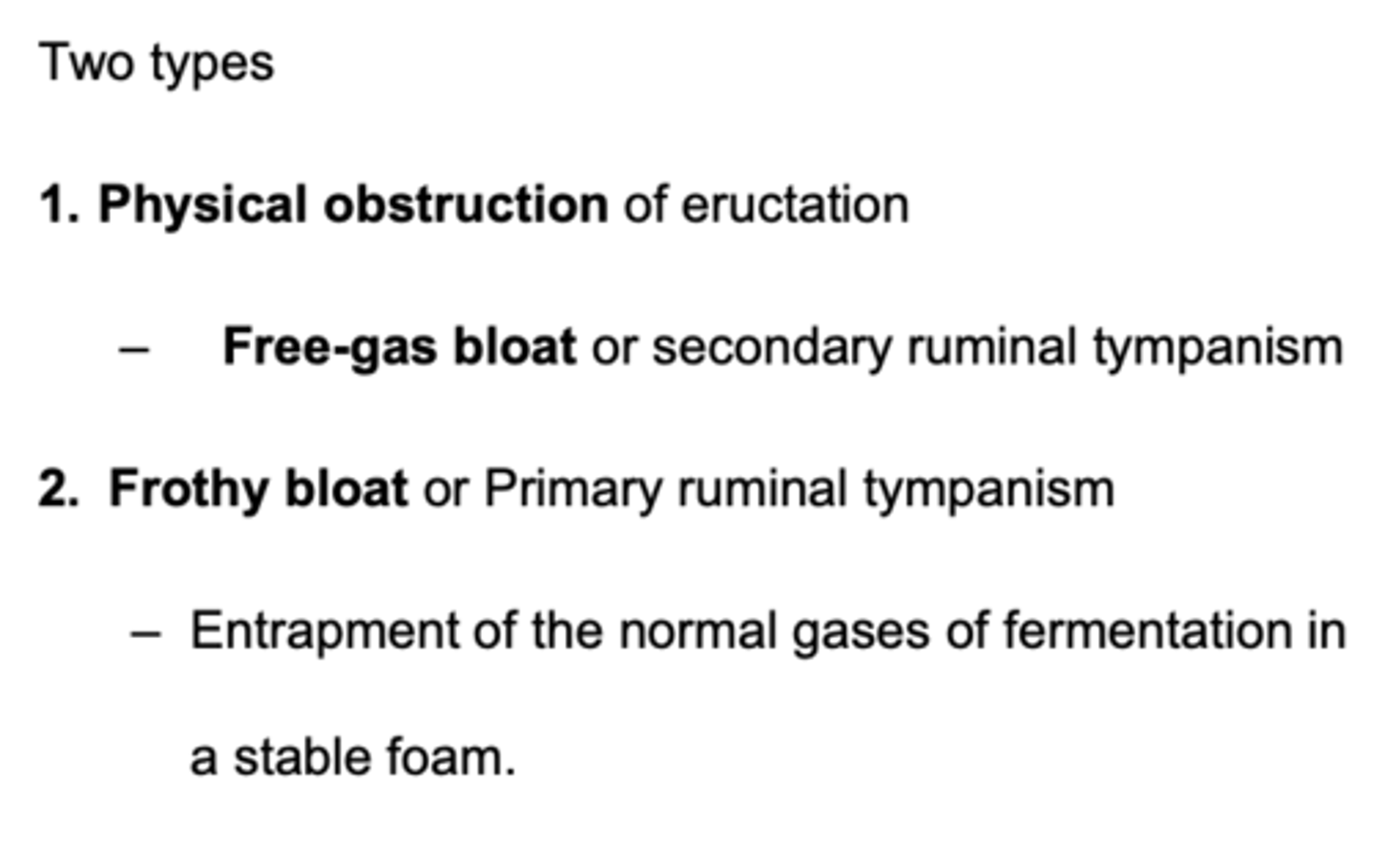
what is frothy bloat?
entrapment of the normal gases of fermentation in a stable foam → prevents eructation → gas accumulation
caused by diet (legumes, high grain diet)
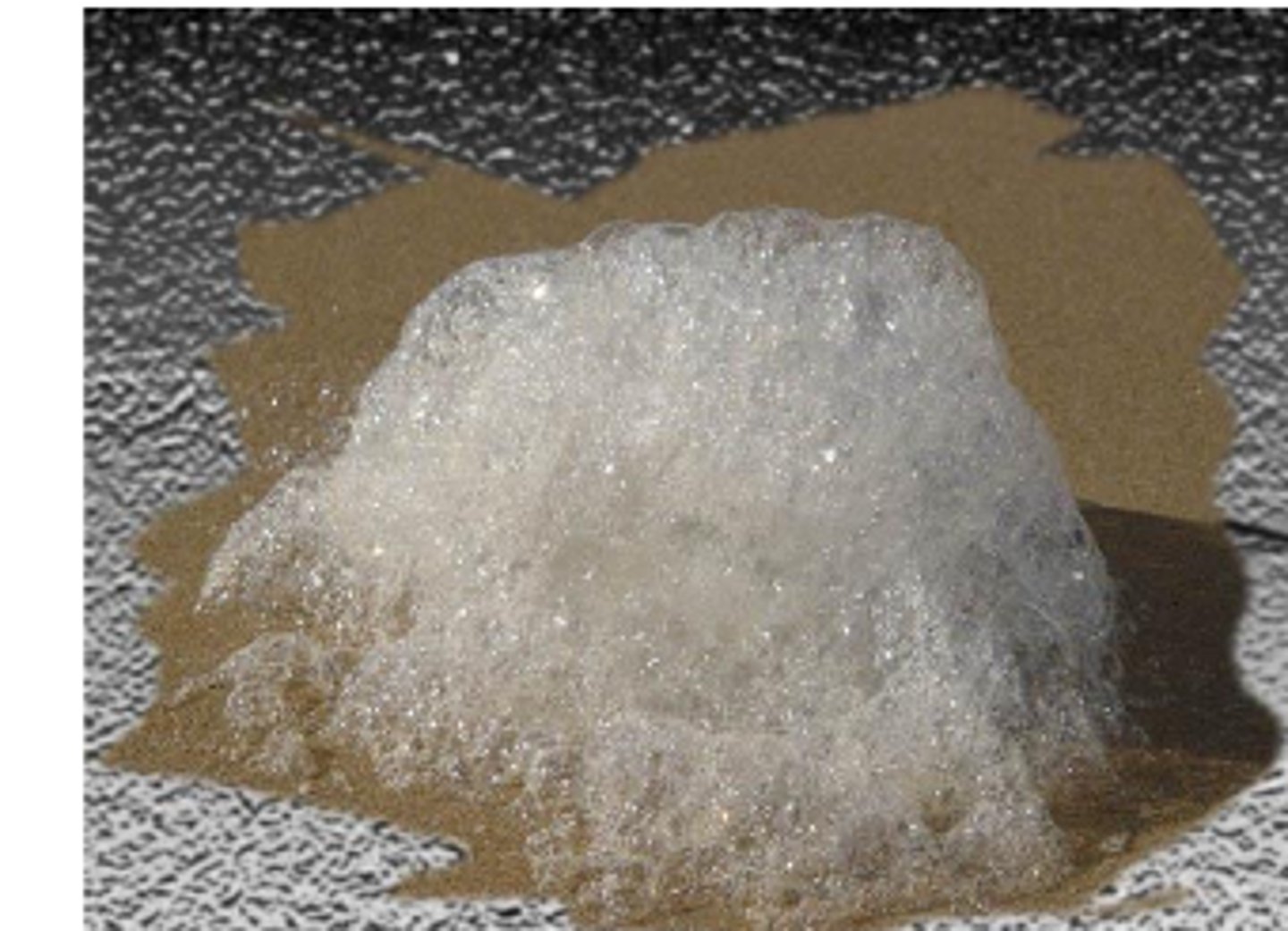
what can cause free-gas bloat?
physical esophageal obstruction:
-foreign body
-stenosis
-pressure from outside of the esophagus
alteration of motility:
-hypocalcemia
-vagal damage
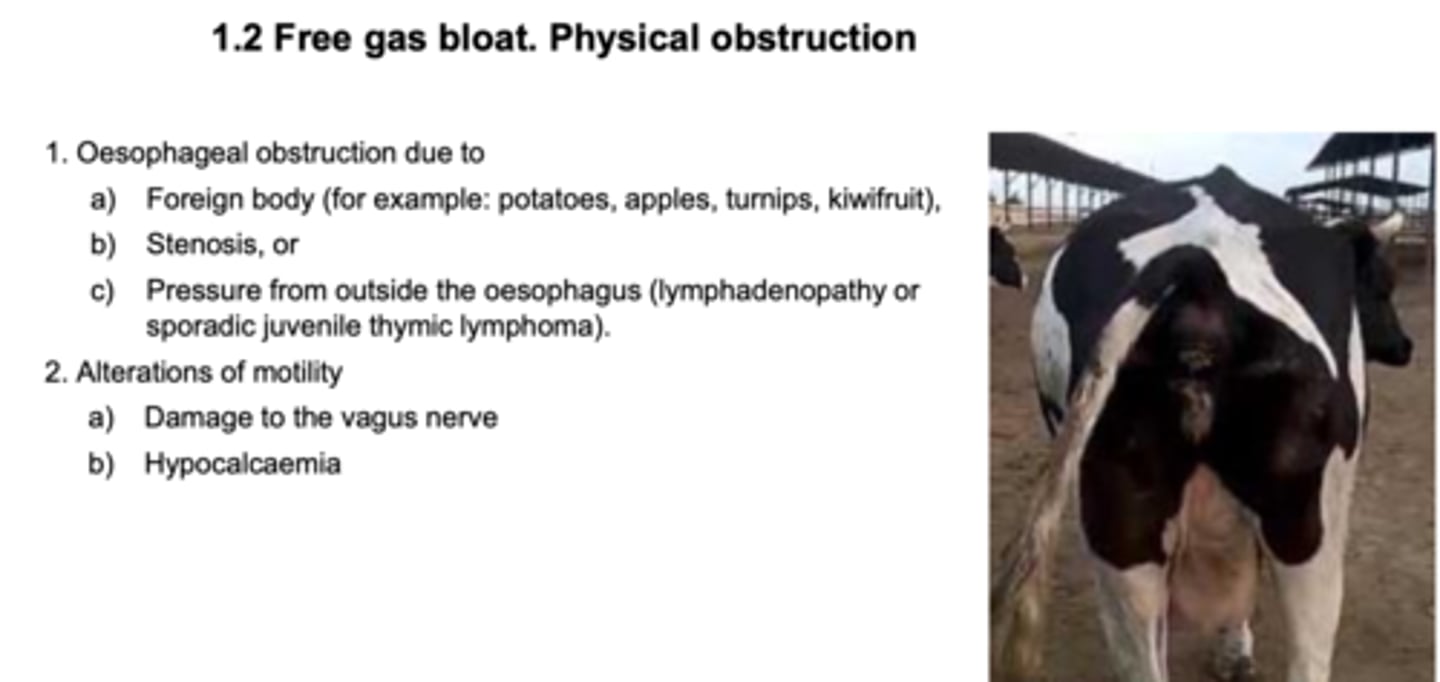
any interference with eructation can cause...
ruminal bloat/ tympanism/ meteorism
the accumulation of free gas in the rumen will cause _____ compression, which then causes _____
diaphragmatic compression;
respiratory and circulatory insufficiency
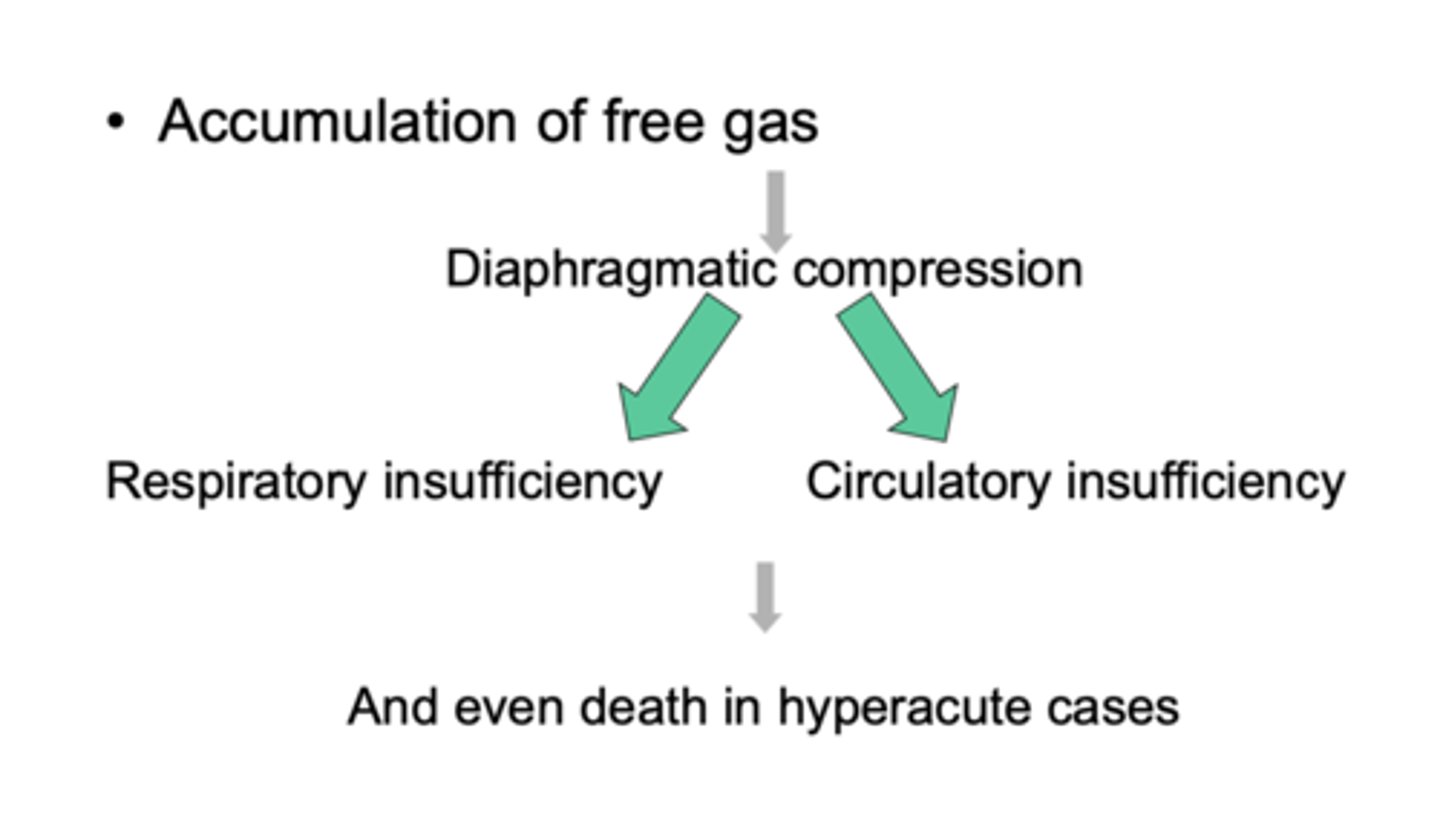
what are the main clinical signs of ruminal bloat?
1. abdominal distension
2. reluctance to move, stop eating
3. behavioral signs of distress (anxiety, vocalization)
4. respiratory distress (tachypnea, orthopneic position)
5. staggering and recumbency
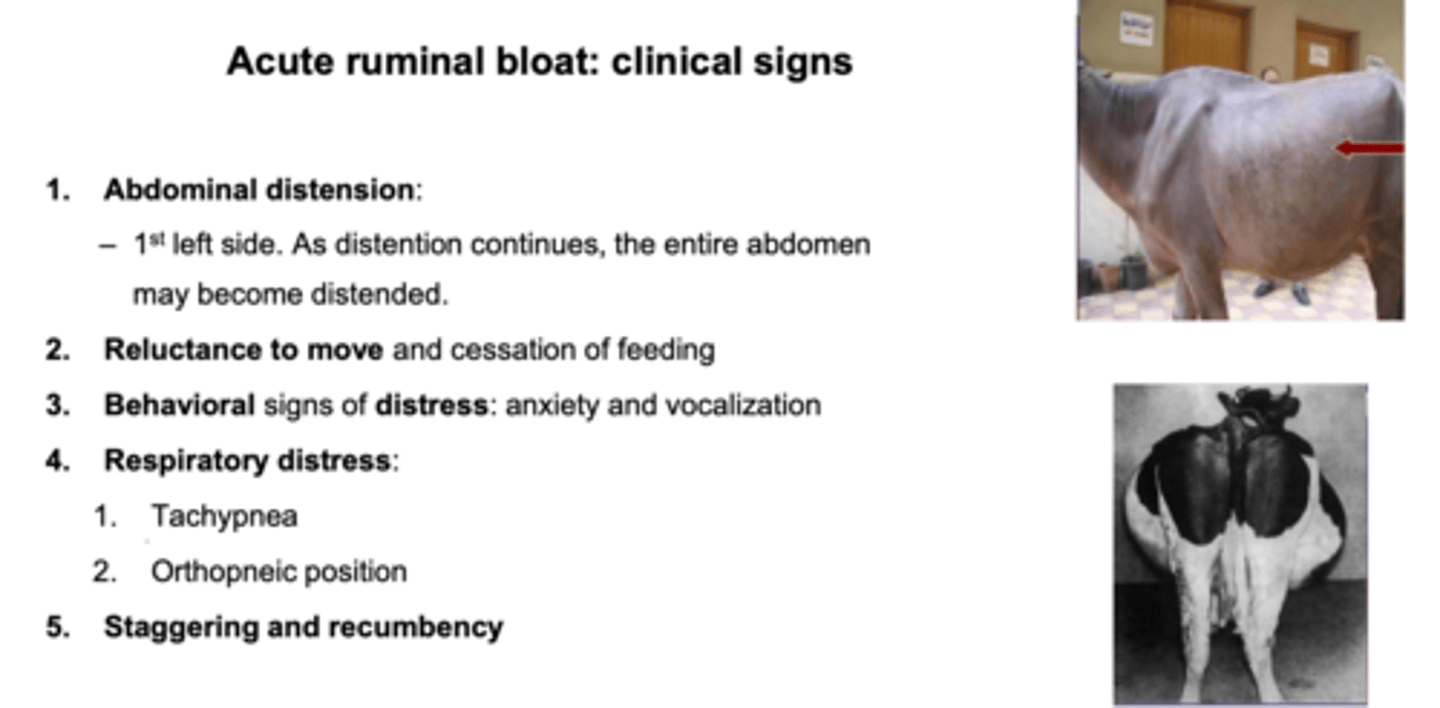
there is a cow on the farm with her left abdomen distended. she doesn't want to eat or move and is making strange noises.. what can we suggest to put on the differential diagnosis?
ruminal bloat/ tympanism/ meterorism

ruminal bloat affects the _____ side of the abdomen first
left
then as it continues, it can distend the entire abdomen
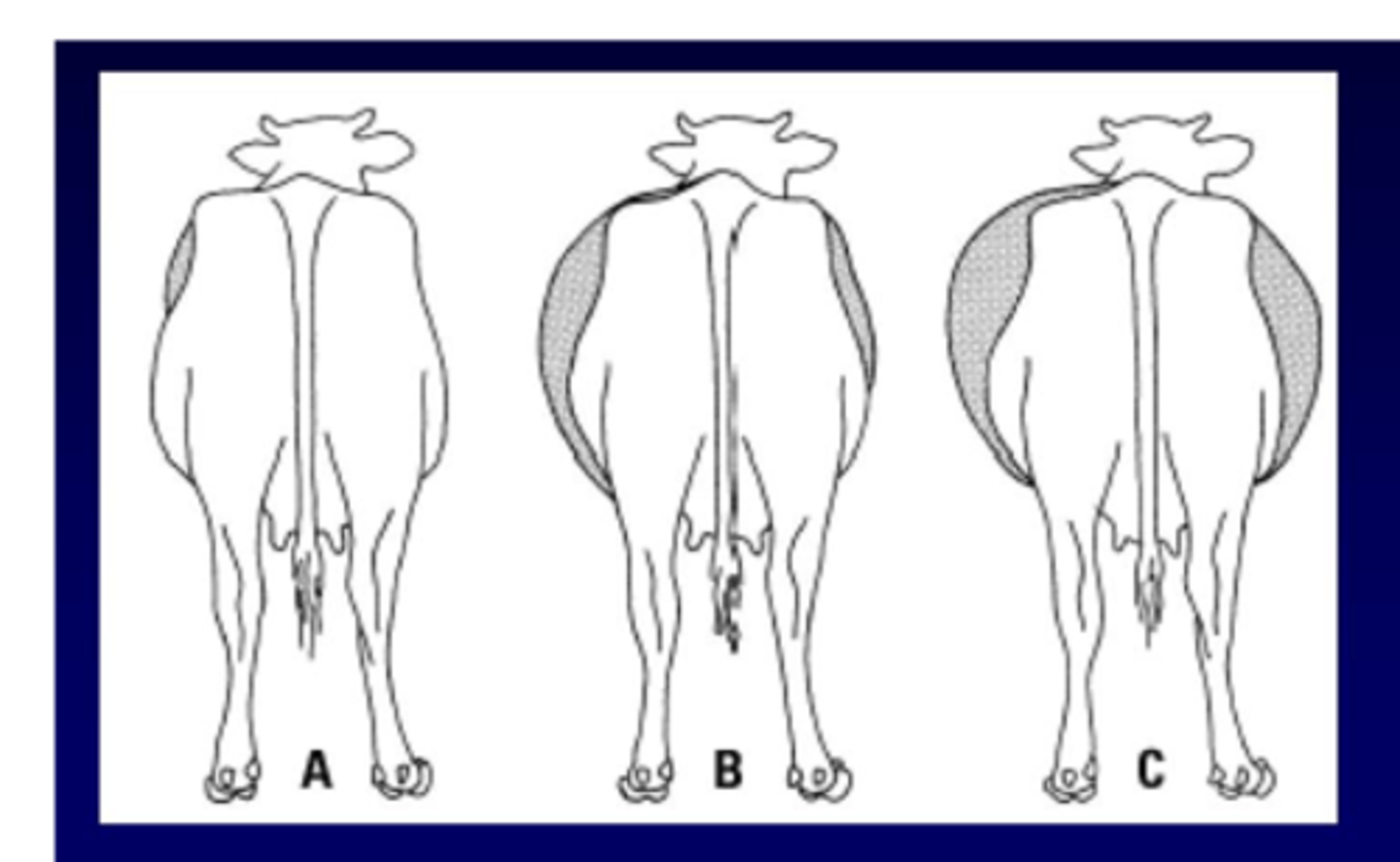
how do we fix acute ruminal bloat?
gastroesophageal tube to relieve air in the stomach
create a hole in the abdomen to release air
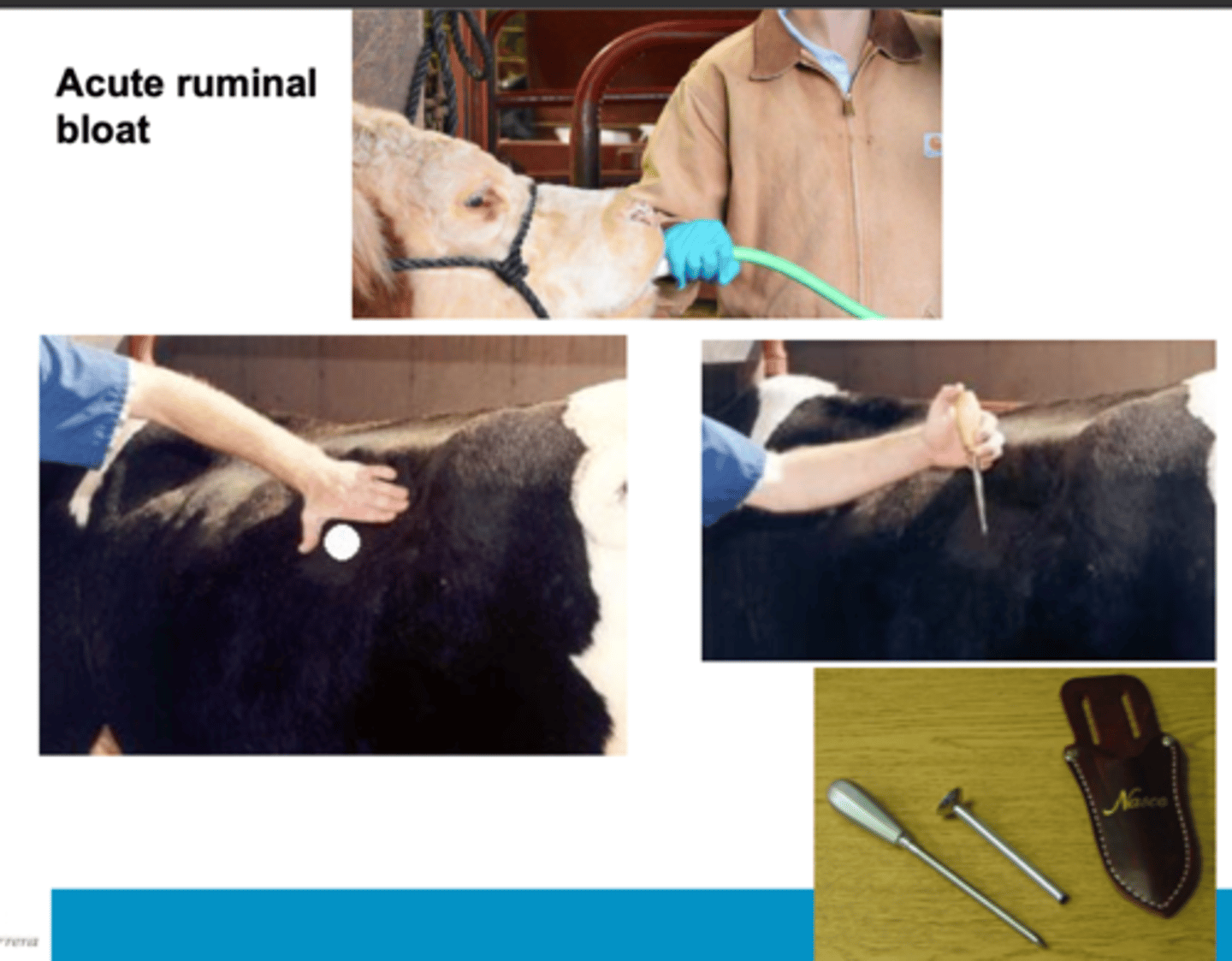
traumatic reticuloperitonitis is known as ____ disease
hardware
because it is usually caused by a sharp metal object
what is traumatic reticuloperitonitis?
inflammation of the reticulum and peritoneum due to a foreign body that perforates the reticulum walls.
it can progress to damage the myocardium, pleura, and liver.
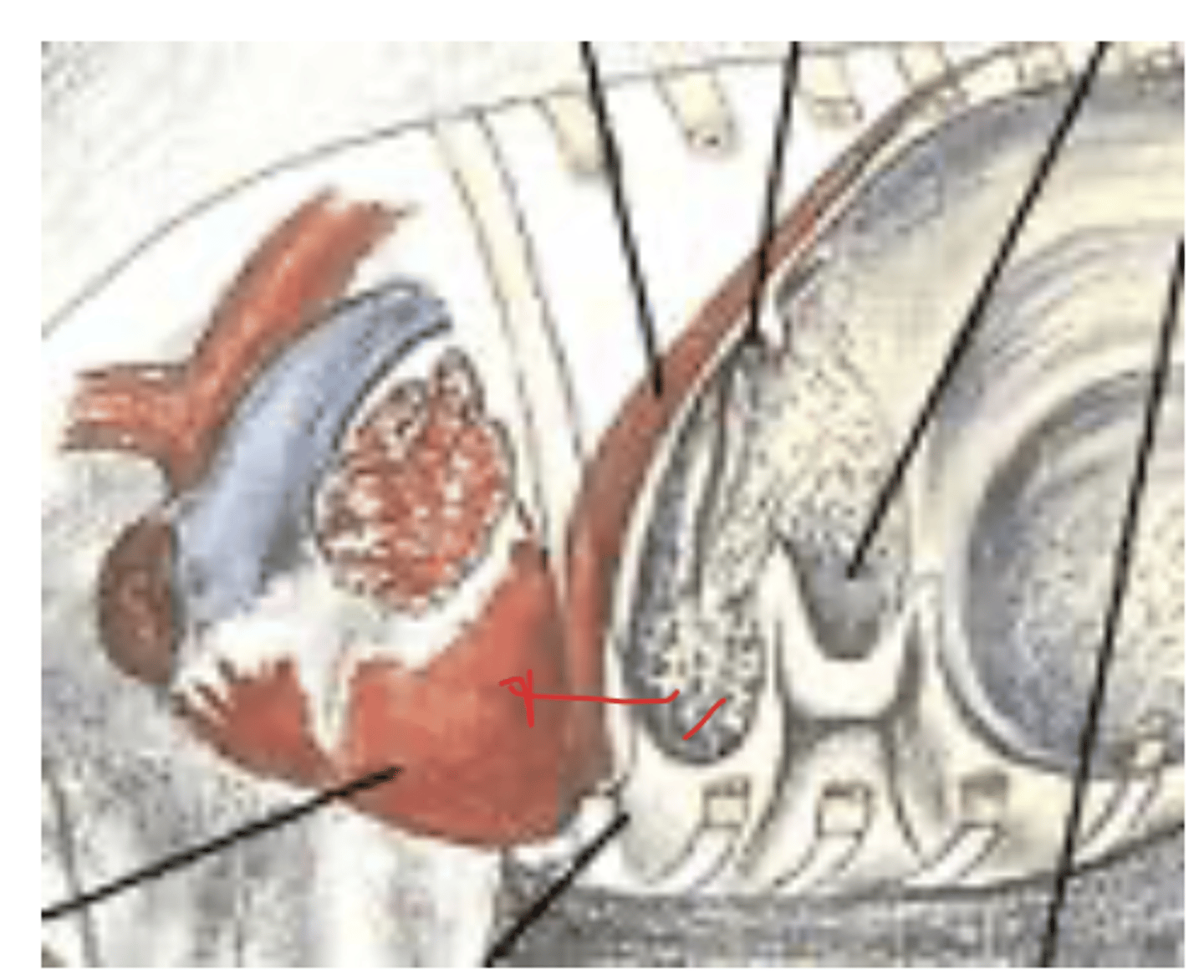
what is the common cause of traumatic reticuloperitonitis?
primary cause:
perforation by a sharp object that was ingested by the animal
predisposing causes:
pregnancy
bloat
strong muscle effort

what can predispose a cow for traumatic reticuloperitonitis?
pregnancy
bloat
strong muscle effort
a non severe case of traumatic reticuloperitonitis involves...
metallic foreign body in the reticulum only, causing chronic indigestion
a severe case of traumatic reticuloperitonitis involves...
the foreign body penetrated the reticulum → gastric contents leak into the peritoneal cavity
what is the most severe form of reticulopericarditis?
Reticulopericardioperitonitis- when the foreign body penetrates the reticulum and reaches the pericardium and pleura, and causes pericarditis
regarding traumatic reticuloperitonitis what is diffuse peritonitis?
acute peritonitis, characterized by:
-fever
-tachycardia
-total cessation of milk production
-acute pain when palpated or walking
regarding traumatic reticuloperitonitis what is localized peritonitis?
chronic peritonitis, characterized by:
-weight loss
-anorexia
-edema in the sternal area
-↓ milk production
-chronic ruminal bloat
-abdominal mild pain
for a cow with peritonitis, how can we distinguish if it is acute or chronic?
based on clinical signs:
acute (diffuse) peritonitis:
-fever
-tachycardia
-total cessation of milk production
-acute pain when palpated or walking
chronic (localized) peritonitis:
-weight loss
-anorexia
-edema in the sternal area
-↓ milk production
-chronic ruminal bloat
-abdominal mild pain
if the cow has reticulopericardioperitonitis, how does it look clinically?
signs of reticuloperitonitis + fast, shallow respiration, muffled cardioresp sounds, jugular vein distension, sternal edema
how can we treat reticuloperitonitis?
treat the signs and damage, but also remove the metallic agent with this magnet that we make the cow eat
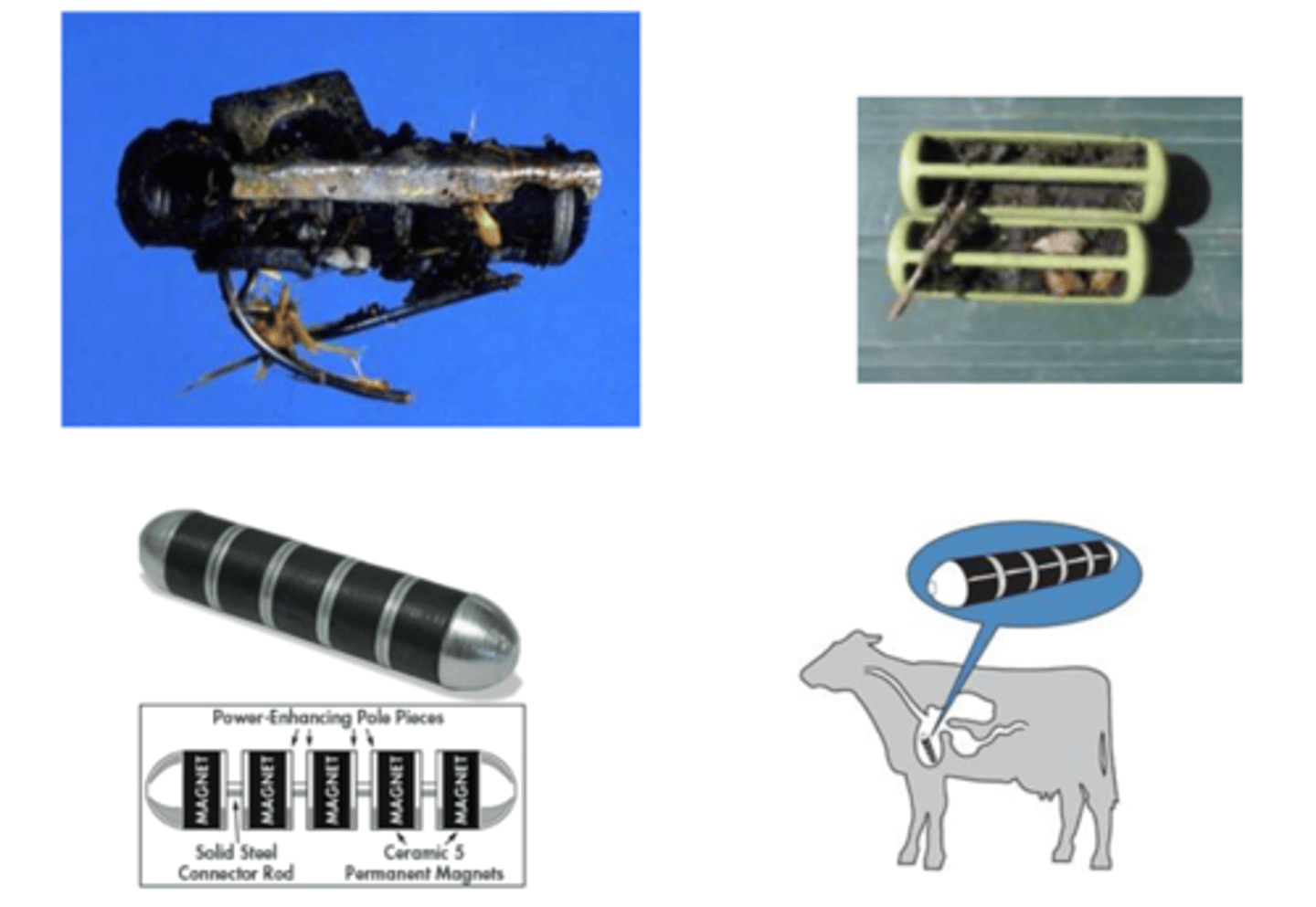
what is lactic acidosis?
the most severe acute digestive pathology (can be lethal in <24 hours)
sudden diet change to readily digestible carbohydrates → very rapid carbohydrate fermentation → volatile acids → ↓ pH
also called grain overload
which is the most severe acute digestive pathology?
lactic acidosis
what causes lactic acidosis?
sudden diet change to readily digestible carbohydrates (forage → grain)
because the ruminant does not have the proper microflora to digest it
can occur by:
-accidental access to large amounts of grain
-feedlot cattle that are introduced to heavy grain diets too quickly
-antibiotic treatment
a sudden change in diet from forage to grain is dangerous to cattle because...
it can cause lactic acidosis
because the cattle does not have the proper ruminal microflora to digest it, and will produce high amounts of volatile acids, causing acidosis
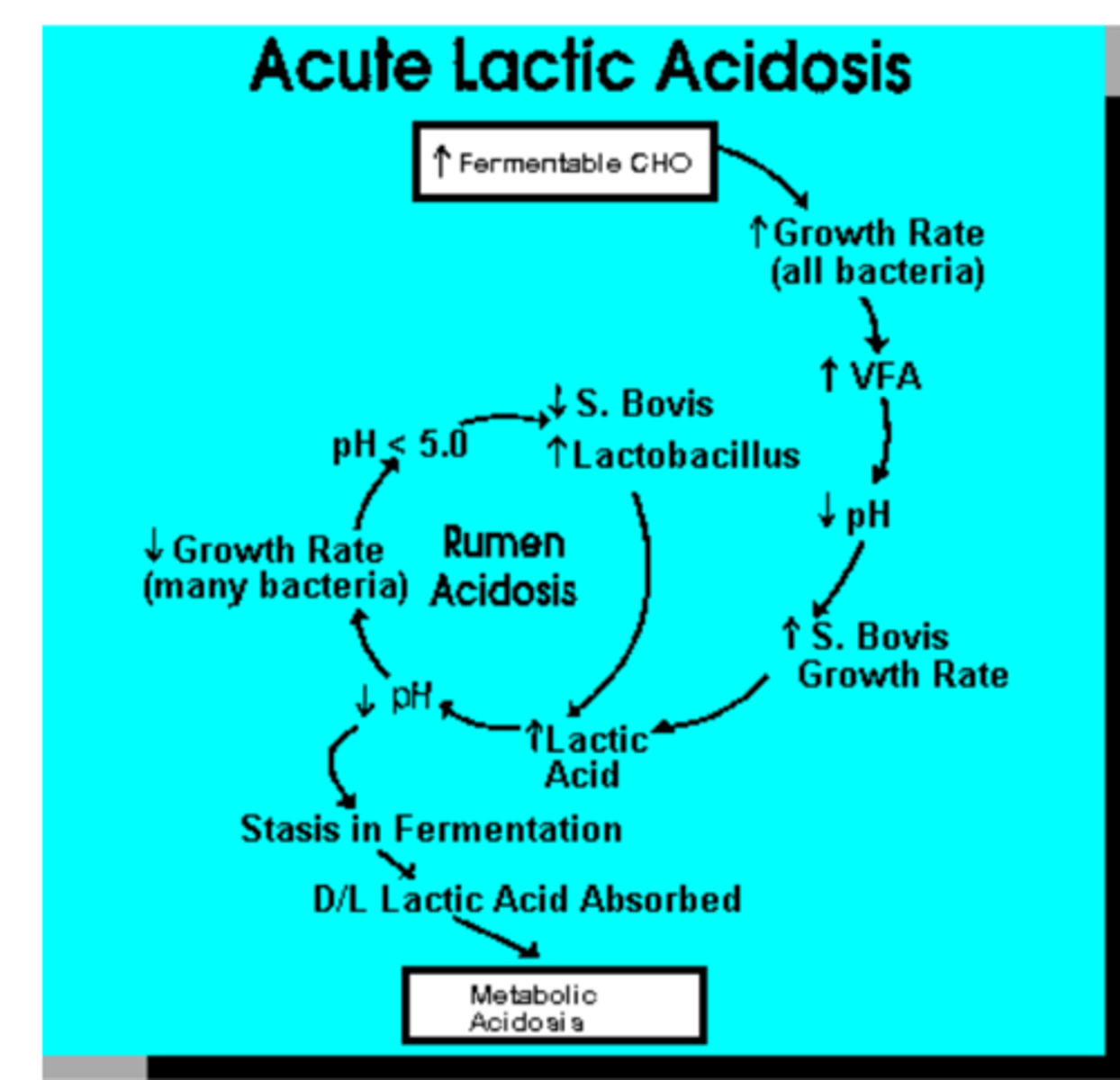
why is a sudden drop in pH in the rumen lethal for the cow?
↑ osmotic pressure in the rumen → diarrhea and dehydration
metabolic acidosis if absorbed into the blood
Proliferation of Clostridium → bacterial toxins → rumenitis → hepatic abscess and sepsis and ruminal paralysis → death
we should be feeding cows _____% forage and _____% grain.
why is this so important?
60% forage
40% grain
because this allows for adequate saliva production, which balances the rumen pH.
if we fed more grain and less forage, saliva production will not be sufficient for pH balance, and lactic acidosis will occur
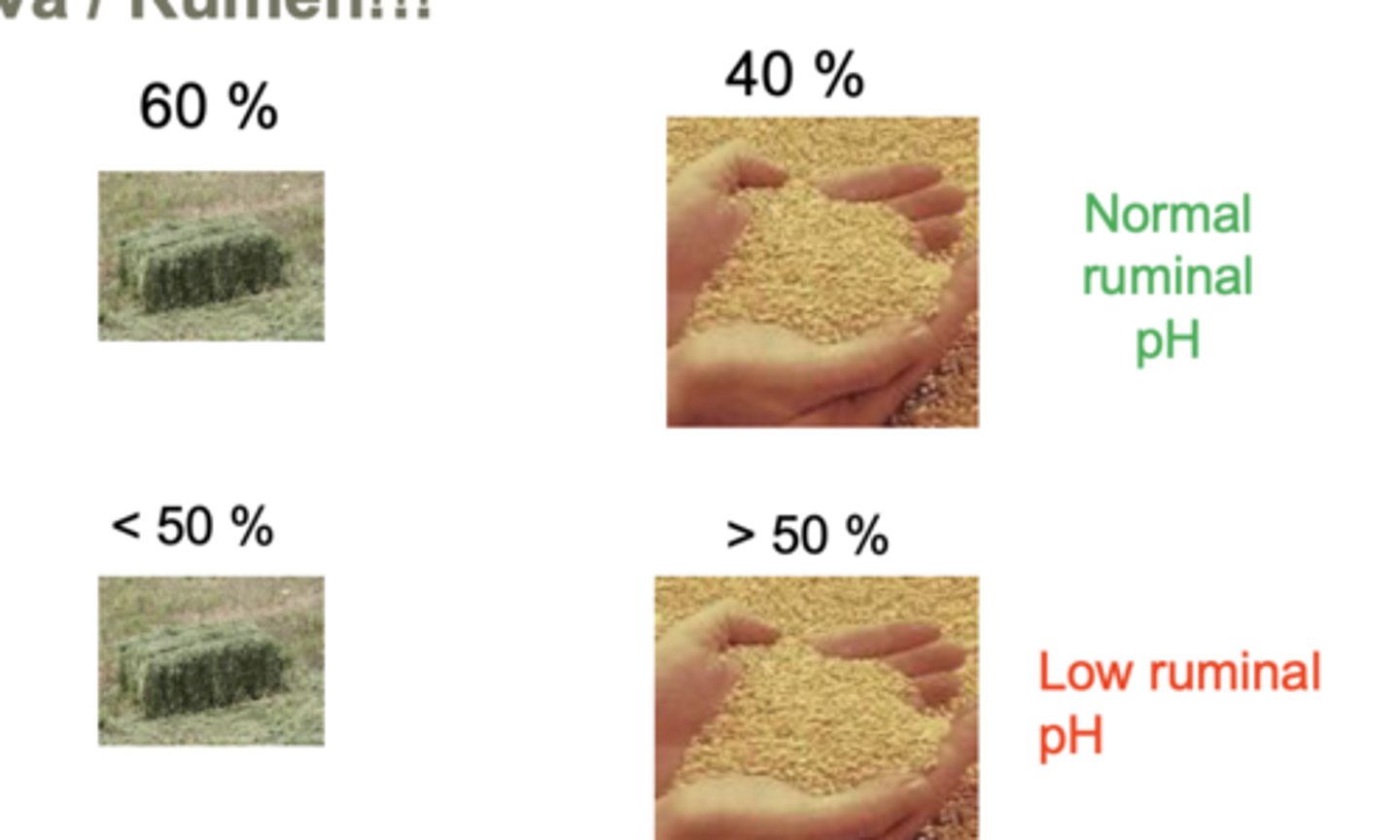
what is a displaced abomasum?
displacement of the abomasum, towards the top of the abdomen after filling with gas.
this is possible because the abdomen is very loosely suspended and can be moved to the left or right side easily
LDA is more common than RDA
how common is displaced abomasum?
2-5% in intensively managed dairy cattle
it is the most common cause of abdominal surgery in dairy cattle
the most common cause of abdominal surgery in dairy cattle is _____
displaced abomasum
what is the problem with a displaced abomasum?
it will prevent the natural passage of gas and feed through the digestive system, creating a restriction.
LDA:
-can cause torsion, interfering with blood supply
-dehydration
-metabolic alkalosis and leaking of hydrochloric acid into the abomasum
-hypopotassemia
-ketosis
RDA:
-complete torsion and occlusion of blood supply
-LDA signs, but WORSE
-circulatory failure
-metabolic alkalosis → metabolic acidosis
what are the etiologies of displaced abomasum?
recent pregnancy: there will be changes in the position of abdominal organs, and also insufficient food intake which leads to hypocalcemia and abomasal atony and ↑ gas
body conformation
+concentrate and -forage diet: will cause ketosis and abomasal atony and increased has production
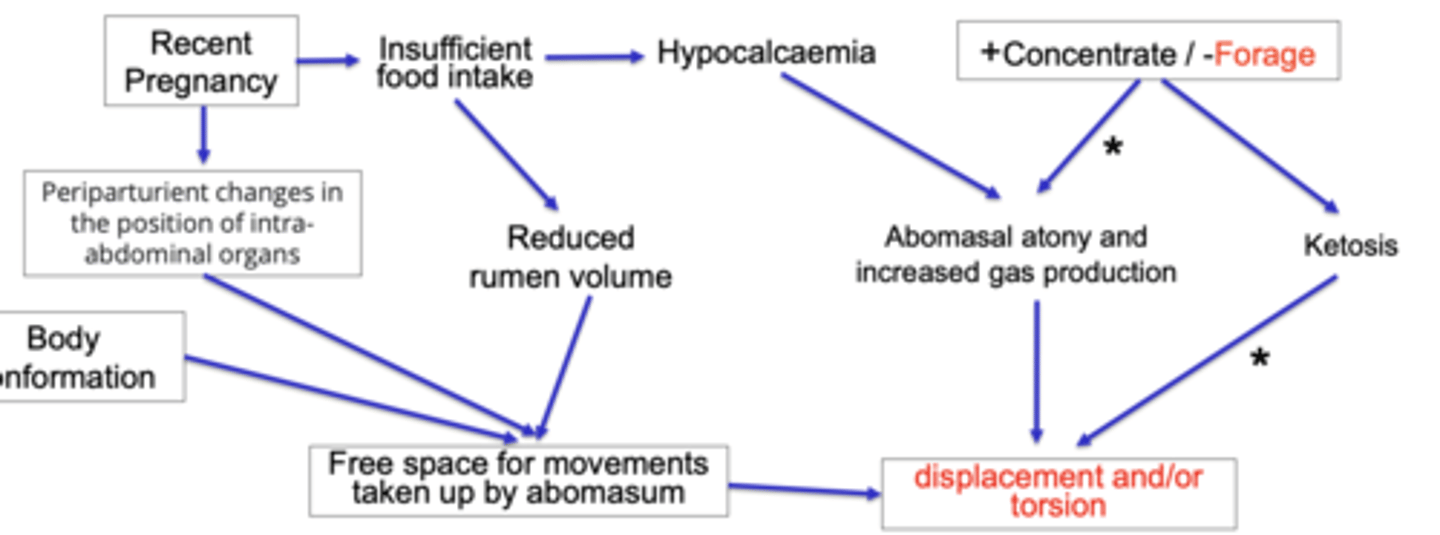
how can a recent pregnancy cause displaced abomasum?
-changes the position of organs
-insufficient food intake → hypocalcemia → abomasal atony and ↑ gas production
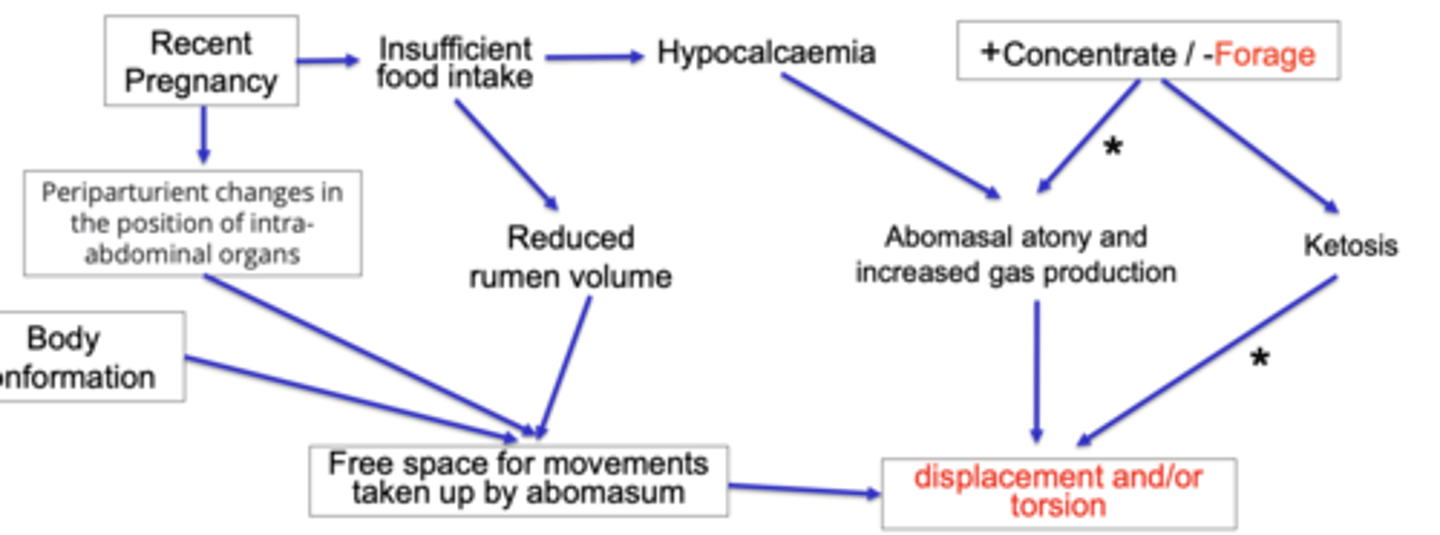
how can a high concentrate and low forage diet cause displaced abomasum?
it will cause abomasal atony, ketosis, and ↑ gas production
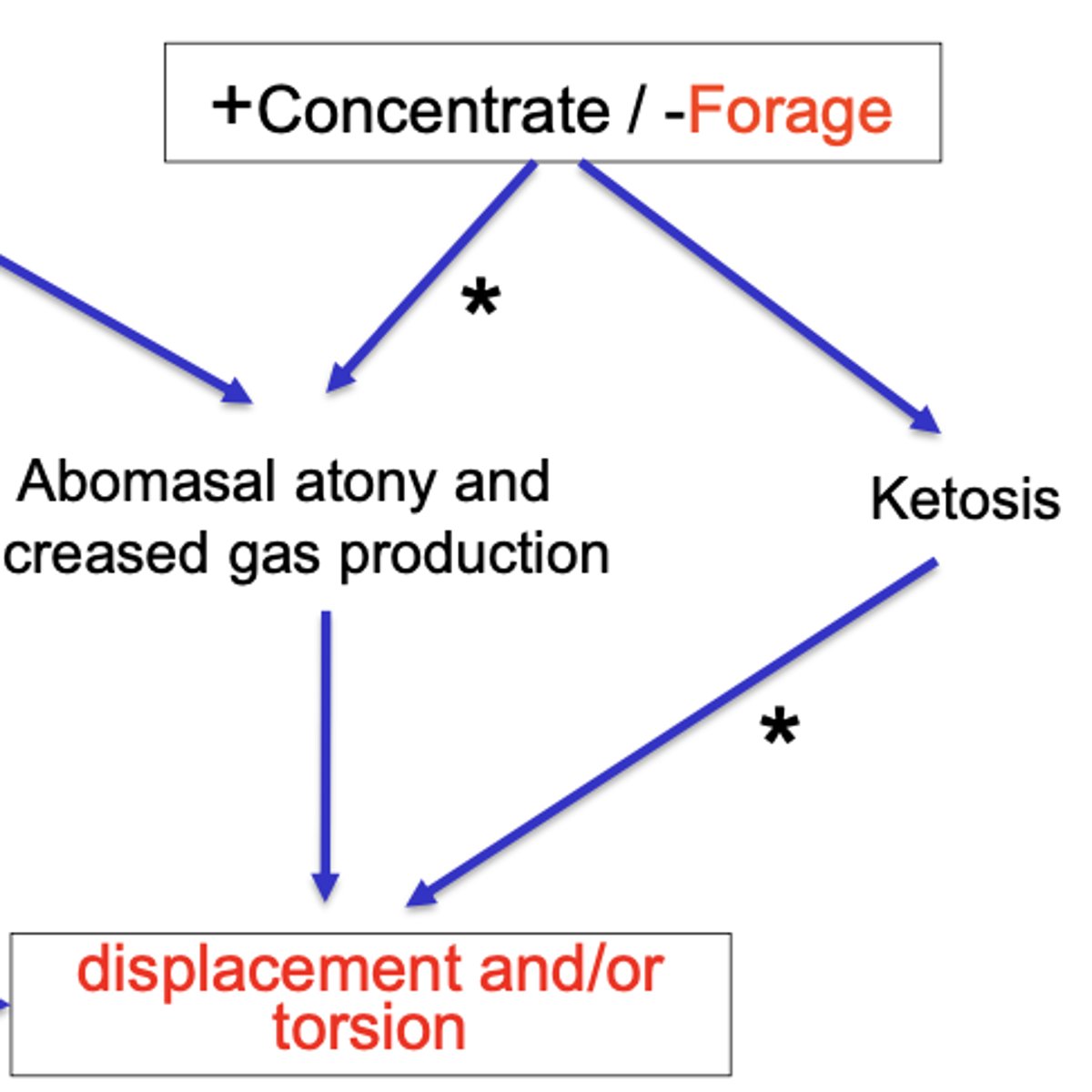
which is worse- LDA or RDA?
RDA
because it commonly causes complete torsion and volvulus. the signs will be the same as in LDA, but much worse.
-dehydration
-metabolic alkalosis → acidosis
-hypopotassemia → ↓ CO
-ischemic necrosis
-circulatory failure
what are the clinical signs of abomasal displacement?
-50% less milk production
-↓ appetite
-"ping" sound heard when the area is hit with fingers while you auscultate
no temp or HR changes
what is the treatment of LDA or RDA?
surgery on the field.
★ omentopexy and muscular and skin suture
make an incision and reach in your hand to put the abomasum back in place. then suture it to the muscle and skin.
